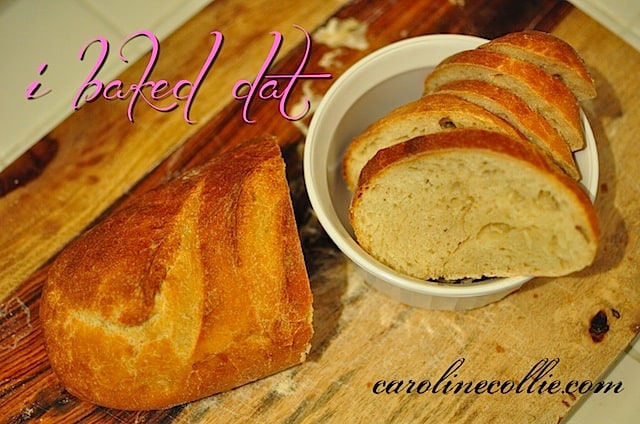When we got back to the States and I saw the cost of a nice loaf of bread, I was more than a little bummed. My awesome health insurance plan in South Africa gave us discounts on healthy food purchases {brilliant idea, American insurers, take this one up!} so we got really nice, healthy bread at a very fair price.
The Hubs bought some cheap bread at the Piggly Wiggly not long after we settled in, not knowing what he was signing up for. When he tried to spread some peanut butter over a slice and the bread tore, we knew we had a problem.
Cheap bread is full of yucky stuff, and cheap in the bad sense. Healthy bread is pricey. Where’s the third option, pray tell?
Shortly after this perpuzzlement, I heard a rave review (by the Nester) about a book called Artisan Bread in Five Minutes a Day and I asked my Mom for the book for Christmas. I also got a pizza stone from my Dad for Christmas, and a wood cutting board that has been helpful in the process. But neither of those are an absolutely necessity starting out.
I was hesitant to think it could possibly work out well, and pleasantly surprised when it did.
And when my awesome piano playing, great-cooking, tidy housing, homeschooling awesome awesome photo-taking (yes, I needed to say it twice) friend Hope asked about it, I suddenly realized I needed to share.
And then I got really excited and created a picture with text and if you pin it on pinterest I might wet my pants.
Twice.

Anywho, about the book.
The premise is that you can mix together a nice heap of dough (the kind made from flour, not the cash) with the book’s very good instructions, and that probably takes ten or fifteen minutes, tops. And you can keep said dough in your refrigerator for up to two weeks. When you’re ready to bake a loaf, you grab a chunk of the dough, shape it based on what you’re making, let it rest according to the recipe’s instructions (usually about 20-40 minutes while the oven and your pizza stone are preheating) and then you bake 30ish minutes, depending on the recipe. {That whole process probably takes five minutes of active effort. For me, maybe seven.}
And boo-yow. Yum.
So far I’ve just tried a few variations of the most basic recipe (I wanted to use white wheat flour once and I accidentally bought the wrong type of flour the first time because there was this gentleman at Walmart who used to be a chef and loves to bake and we had a really long conversation about the book, different types of flour, and the fact that I couldn’t find an oven thermometer. He came and found me again later and had an oven thermometer to drop in my cart.
{Thank you, dear Sir.}
I have really, really enjoyed this learning experience, and the fruit of it, so far.
My honest review?
THE PROS:
- The bread is really good. As in, it tastes really good. And I’m still just rocking the basic basic recipe. Pass the oil and balsamic, please.
- It has just four basic ingredients: flour, yeast, kosher salt (usually) and warm water. (Which seems healthier, methinks, than all those funky ones I can’t pronounce.)
- It is really an un-time-consuming process that could work for a Mom who gets home at 5 or a Mom who’s home all day. Or a Dad. Or grandma.
- My Dad and I worked out some rough figures on the math and using a nice unbleached white flour I was probably averaging 40 cents per loaf. Mixing in some unbleached white wheat, I probably knock another 15 cents off. And up the health factor. Ka-chow!
- One single batch of dough will make four loaves, which will stick around for about a week around here because I don’t make it every day. (You can easily double the recipe if you want more, and I think that’ll maybe add a minute or two to your mixing time.)
- The book has a ton of recipes in it and I’ve just scratched the surface, trying to get the hang of things before I start getting fancy. {Watch out instagram!}
- It works as bread for sandwiches — the bátard {appreciate that I looked up that special character just for you} is nice, though a bit holey sometimes. I haven’t tried doing it in a loaf pan yet, but apparently you can do that to. I’m just scared because I’m not sure if the loaf pan I inherited is a proper nonstick.
- All the boys love this bread. The Hubs, the Bear, Tiger Tank — six thumbs up.
THE CONS:
- The loaves are smaller than I expected. They are, however, a good-sized accompaniment to a meal. A loaf will probably get finished if four adults are at the table. {You might want to just make two loaves and throw them in the oven together if you have a big family.}
- Because the loaves are small, they go quickly. Baking a loaf of bread has become a part of my morning routine so that we have it for lunch. That may or may not work for you. {It doesn’t last for lunch the next day because we almost ALWAYS eat the rest of the loaf with dinner.} I’m still planning to get a bread maker to do sandwich loaves, but I will also keep doing this type of bread — sometimes for lunches, often as the perfect accompaniment to spaghetti and salad or curry and rice or… I haven’t found a meal it doesn’t play nicely with yet. Pass the oil and balsamic please.
- It’s a learning process. Your first few loaves might be wonky. One of mine had a booty like J Lo.
- It’s an investment, though not a ginormous one. The book, $13 used, a pizza stone if you really want to give it a proper go, though you can try it with a baking sheet for the first wee while if you want. They recommend a food grade storage container for keeping the dough in the fridge, but I’ve been using a really big pot with a lid, since it’s not supposed to be airtight anyway. I hope that’s allowed.
- I feel like I should have more cons but I’m struggling to think of anything else.
MY RESULTS:
So far, really good.
Here’s an early loaf awaiting its destiny:

This may have been the one that had a booty. It tasted good anyway.

My prettiest loaf so far accidentally flipped over when I was sliding it onto the pizza stone. I tried to flip it back, but it was stuck, so I just wet and slashed the other side. I prayed a little. It came out gorgeous.
Here’s a more recent one:

Do you sense the improvement? Are you impressed?
And here’s today’s loaf, a bátard, which started all these shenanigans. {I posted it on instagram, which Facebooked it.}

It would feel cheeky and morally wrong {not to mention probably disrespect the laws of copyright} to give you the recipe that these writers/bakers worked countless hours perfecting — and I also think you need all of the surrounding instructions from the book to give it a proper go. And they are thorough, though not too lengthy. I hope that doesn’t bum you out.
The Good News? You can get the book used on Amazon for like $12.58. And for that price, even if you only bake a dozen loaves, you’ll have paid for the book. I love you and I like sharing recipes here, but I don’t want to go to jail.
Think you might give it a whirl? Got any questions? Please fire away in the comments!
xCC
The folks who wrote this book don’t know me. But I am an Amazon affiliate. {In case you don’t know, that means that if you click that link up there and then decide to buy the book, I get a tiny percentage of the sale. I might also wet my pants.} But I’m telling the truth and not aiming for the cut. Scout’s honour.

 I create resources to help people find deeper, more meaningful relationships with God through pursuing, pondering, and prayer. The "Shop" link above will take you to the home of many of the lovely resources I’ve created to help you keep walking one day deeper with Jesus.
I create resources to help people find deeper, more meaningful relationships with God through pursuing, pondering, and prayer. The "Shop" link above will take you to the home of many of the lovely resources I’ve created to help you keep walking one day deeper with Jesus.